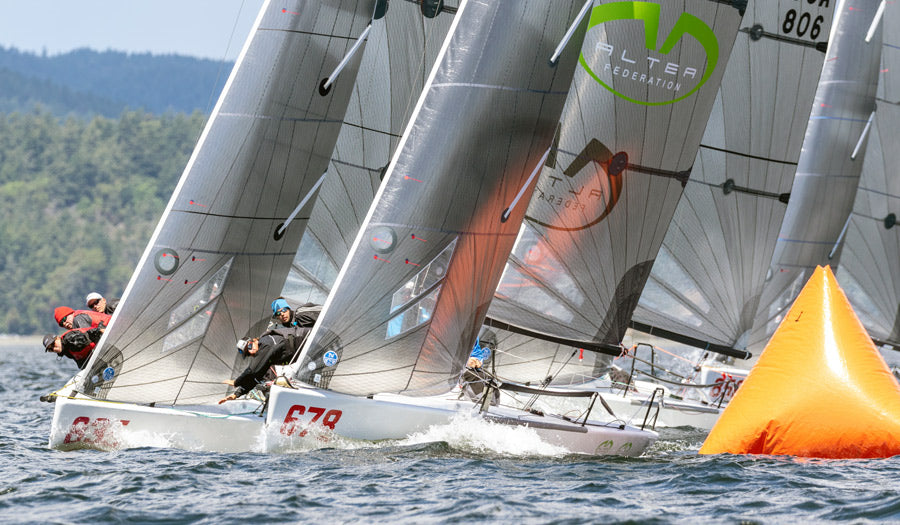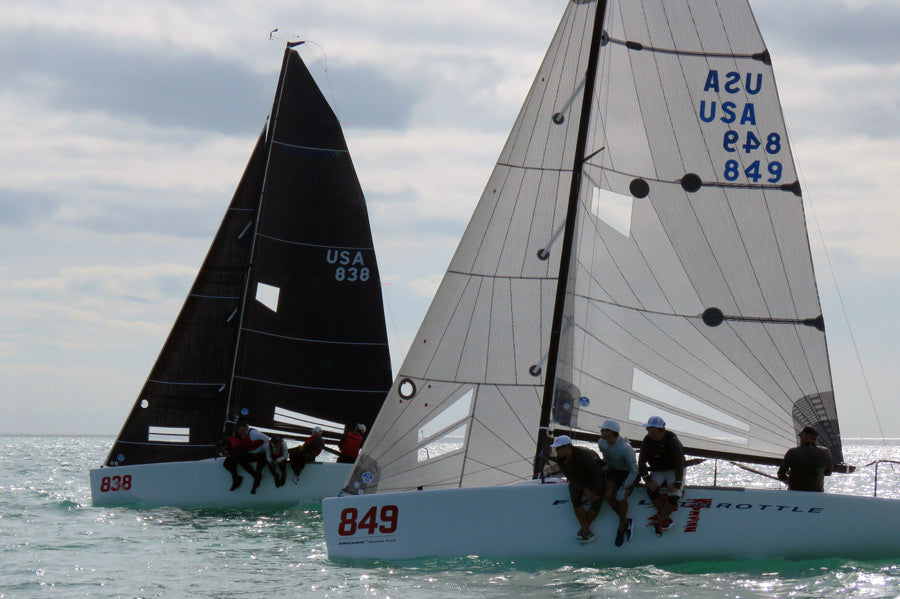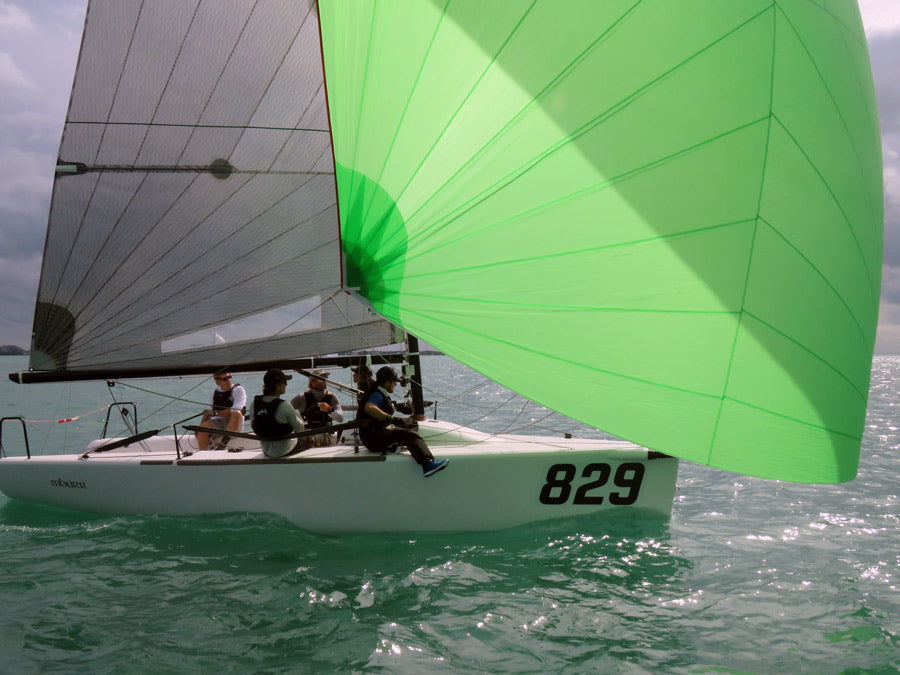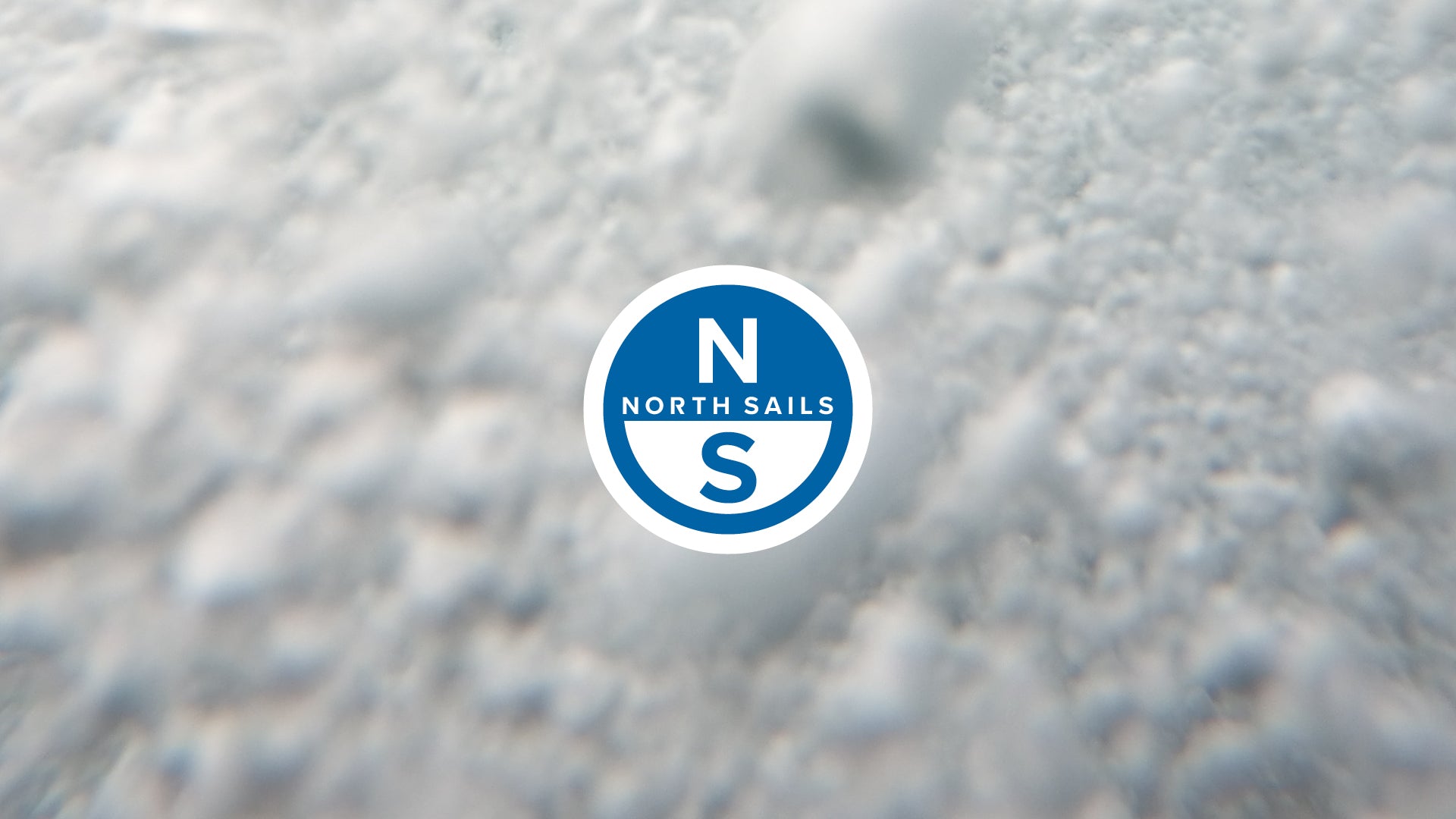MELGES 24 SPEED GUIDE
Class leader Brian Janney answers your Melges 24 speed and boathandling questions.
Who sails in the Melges 24 class?
In the early 2000s, sailors in the Melges 24 class began to enlist coaches and include professional sailors in their crews, but that trend collapsed and participation dropped way off after 2009. Gradually, the class has been growing again and we are seeing an increasing number of Corinthian teams sailing at major events, using older boats. Local fleets are coming back in North America also, in places such as Vancouver, Western Michigan, and Atlanta. There are more regional regattas on the schedule, and they are by nature much more Corinthian. (Learn more at the International and North American class websites.)
How physical is the Melges 24 to sail?
The Melges 24 is a great boat if you like to be active when you sail. It requires athleticism, but not brute strength. The loads are not that high and there are no winches—ratchet blocks only. You have to hike hard, but since the class changed to shorter stanchions and tighter lifelines, hiking is less painful. Overall, it’s a good combination of keelboat and dinghy. In light air, it rewards roll tacking and jibing, but in heavy air it loads up like a keelboat and you have to think about the timing of your maneuvers.

Athletic sailing is the norm for Melges 24 crews, shown here after a start at the 2018 Melges 24 World Championship. Piret Salmistu/IMCA photo
What are the top 3 ingredients to compete successfully in the Melges 24?
- Practice mark roundings—good sets and douses are key.
- Practice light-air downspeed maneuvers—the pre-start under main alone is key.
- Build a consistent crew—top performance is all about teamwork.
What is the ideal Melges 24 crew size?
Top teams sail at the max weight limit of 825 pounds (375 kilograms). The majority sail with five in the crew. Larger people sail with four.

Crews sail with four or five to meet the crew weight maximum of 825 pounds.
What does each crewmember do on the Melges 24?
The helm drives and handles mainsheet and backstay. The tactician trims the jib upwind and sometimes handles the mainsheet downwind. The spinnaker trimmer hikes upwind and hoists the chute if they are the biggest crewmember. On a boat sailing with five, the two forward crew furl the jib, douse the spinnaker, and handle the tack line and pole.
On boats sailing with four crew, the forward crew handles the tack line, jib furl, and spinnaker hoist/retrieval.
The tactician pulls the pole out and then grabs the spinnaker sheet, handing it off to the trimmer once the halyard is up.
New or used Melges 24s— what are my options?
A new Melges 24 costs in the $70,000 range and includes a trailer, covers, and an upgraded line package. The company periodically builds runs of four or five boats. As of 2018, hull numbers ran up to about #900. Used boats range from a 1990s boat for less than $20,000 to somewhat newer boats with covers and a trailer with dock boxes for about $30,000.
Beyond the basics, what kind of prep is needed to make a used boat competitive?
Older boats may need mast-step reinforcement or repair of stanchion bases. They may also need the new, shorter stanchions. The Melges 24 has a carbon-fiber rudder and keel. Look for a boat without dings in the foils, or be prepared to make repairs. We keep a close eye on the trailing edges of keel and rudder. When we trailer the boat, we pad the back of the keel with a pool noodle we’ve cut in half. Check for wear on normal gear as well, such as cam cleats.
The jib halyard system is unique and needs attention on all boats.
Instead of the usual separate forestay and jib halyard, the halyard connects to the wire in the luff of the jib, which then serves as the forestay. Where the wire goes over the halyard sheave, it can break strands on a windy day, so we recommend checking it after every windy day of sailing and replacing the wire frequently.
How do you transport the Melges 24?
Melges 24 trailers come from the builder with shaped supports. The boat rides about five feet off the road, at shoulder height. You put the boat in the water with the keel in the “up” position and then lower it with a “keel crane,” which fits into a molded socket right behind the keel. You can also ramp launch the boat if you wish.
What's involved in rigging and derigging the Melges 24?
To rig the Melges 24, first attach the shrouds, spreaders and backstay, then pull the halyards down from the top of mast. Because the mast is deck-stepped, two people can raise it. Rig the spinnaker halyard forward so it acts like a temporary forestay. A team that knows the process can be ready to launch within an hour. Once you’re in the water, put the keel down, fasten down the cover plate, and attach the rudder. There is a small gas outboard, so once that’s in position, you’re ready to go.
What kind of inventory does North recommend?
North offers the championship-winning 3Di mainsail and jib. There are two spinnaker designs, a reacher and a runner. You are allowed to carry two spinnakers, and most top teams will have one of each aboard. The reacher is used in planing conditions when you’ll spend more time sailing in a “bow up” mode. The runner was recently redesigned to be a bit twistier, allowing a larger crossover with the reacher.
Melges 24 Tuning
What are the most important ways to tune the Melges 24 rig?
Tuning the rig is described in detail in the North Melges 24 Tuning Guide. The key parameters are rake and shroud tension. Because the spreaders are swept aft, as you add tension to shrouds, the mast bends and becomes raked more. Unlike some classes, you’re allowed to adjust the shrouds while sailing; knowing the number of turns for each setting, the forward crew can make the adjustments while hiking. From the base setting to 20 knots, it’s 20 turns. Top boats have shifted to open-body turnbuckles because they’re twice as fast to adjust and easy to pin using a piece of batten held in place with shock cord.
This is the shockcord/batten for quick adjustment of turnbuckles. Photo courtesy APS
What are the key steps to setting up the rig?
The first step is to hoist the internal jib wire and set the rake at the turnbuckle above the Highfield lever. Rake is measured
from the top of the mast to the intersection of the transom and the bottom of the hull. This measurement should be 36’6.5” (11.140m).
 Dial in the rake by adjusting the turnbuckle belowdecks. Photo courtesy APS
Dial in the rake by adjusting the turnbuckle belowdecks. Photo courtesy APS
Next, add shroud tension until it is 16 on the Loos gauge. You may have to adjust the turnbuckle above the Highfield lever to maintain the proper rake adjustment. It helps to have two people to do this.
Are there other special considerations when setting up a Melges 24?
It’s easy to scratch or damage the keel when hauling and launching. The North Tuning Guide includes what to watch for there, as well as several tricks to marking control lines and setting up your deck.
Melges 24 Upwind Sailing
Upwind, where does the Melges 24 crew sit?
The normal or “base” crew position starts with the bow person a half-body width aft of the forward stanchion; all others sit close to the person in front of them. In light air, push the forward crew right up against the stanchion. As waves pick up, everyone moves aft until the aft crew is right against the aft stanchion. The tactician should be the first person to move off the rail in lighter air, so they can trim the jib and look around.

Even in light winds, the Melges 24's powerful sailplan requires the crew to hike.
What do you focus on when trimming main and jib?
Always watch the top telltale on the jib leech when sailing upwind. You can see it through the mainsail spreader window. The jib sheets are on a 2:1 purchase and go through a ratchet block. Two cleats, one on each side of the cockpit, make it possible to “banjo” the sheet in from the weather rail. Usually we don’t play the jib much.
Most upwind control is done with the main due to its large size. In the puffs, the helm pulls on backstay or drops the traveler. Few helmsman are strong enough to play mainsheet, although one class veteran, Brian Porter, can do it and is very fast. Tighten the backstay to keep the boat on its feet and ease when the puff rolls away. Have your forward crew count down to puffs; it really helps the person driving concentrate on boatspeed. Most boats have speedos now, and the helmsman can’t look around, although they do tell the tactician about traffic to leeward since they are facing inboard.
In 12 knots, your jib telltale can be stalling slightly; as it gets windier, ease the jib out half an inch. The jibs are pretty high aspect, and this will create more twist in the head and allow the telltales to stream more. You can also foot a little more, which increases your lift and helps you point.

Hiking as a team upwind in a breeze is vital in the lightweight Melges 24. Piret Salmistu/IMCA photo
Going upwind, how should the top telltale look on the Melges 24 mainsail?
The mains carry quite a bit of twist. In lighter air you’ll close the top of the main for power, but in 10 knots you’re close to overpowered so the top telltale should be streaming. Your helm should be light, nearly neutral, so if you make a change and it gets out of balance, you can tell right away.
What other trim settings should you look for upwind on the Melges 24?
Pay attention to shroud tension. My rule of thumb is to have 75 percent of the backstay on from 12 knots and up. The backstay purchase is at the feet of the helmsman and most people use a number scale on the deck behind that. If you are easing off a lot on the backstay, that means you need to ease shroud tension. If you are close to maximum backstay tension, try tightening the shrouds. We have our tactician watch for that, too.
Who is in the typical dialogue loop and what's a typical conversation?
Probably the most important upwind dialogue is a countdown to puffs—that’s key for the driver. If you don’t depower, the boat will tip over and do a little roundup.

In a good breeze downwind, a top crew slides aft and extends arms and torso outboard to maximize leverage. Piret Salmistu/IMCA photo
Melges 24 Downwind Sailing
Where does each person sit when sailing the Melges 24 downwind?
In lighter air, which we call “soak mode,” everybody pushes forward to get the transom out of the water. The tactician and one bow person are to leeward; everyone else sits to weather. As the breeze comes up, everyone moves to the high side and begins to slide aft. When the boat is on a full plane, everyone except the trimmer moves behind helmsman.

In light air downwind, the crew consolidates their weight at the forward end of the cockpit, with one crew to leeward in front of the chainplates.
What do you focus on when trimming the main and other sails?
The Melges 24 starts planing at about 14 knots, flying all three sails. We call it “lazy planing mode.” Everyone is pushed back against the aft stanchion, hip to hip. As the breeze comes up, move one person behind the stanchion; then move others aft as needed..
In most conditions, trim with a slightly firmer spinnaker luff—not over-trimmed, but not a lot of curl. In light air, ease the sheet and begin to “test” the curl a bit more. As you start planing, you have to trim in as the wind goes forward. Your spinnaker trimmer is sitting down at this point, and your tactician moves aft to trim the mainsheet—at least that’s the norm among tacticians with dinghy backgrounds.
In this Facebook video, the 2018 world champions demonstrate how to sail on a flat-out plane with three sails flying in a strong breeze on Lake Garda (on a day racing was canceled).
What are the key gear shifts in a Melges 24 as wind and sea state change?
The main question downwind is whether you can surf the waves or not. If you can readily plane, sail a couple degrees higher until the Melges 24 takes off. Some people try to force it too quickly and sail a lot of extra distance compared to those who sail lower and slower but cover much less distance. The boats have no wind instruments, so as the breeze builds, those who pick up on this transition first will make huge gains. You need to learn your transition point, which is right at about 14 knots of wind.
Who is in the dialogue loop downwind and what's a typical conversation?
Your spinnaker trimmer and helmsman should always talk about pressure in the spinnaker sheet—typically that means the spinnaker trimmer is talking, or the driver is asking the trimmer what they are feeling. Puff calling is the other key input to the conversation; that should be the same person who was calling the puffs when sailing upwind.
Are there special situations or techniques downwind in the Melges 24?
With the jib unfurled, it takes a little practice to get all three sails across in a jibe. It also requires coordination for the tactician to flip mainsheet over the helmsman’s head at the right time.

On the way to the offset mark, a Melges 24 crew preps the spinnaker to go up (at right) while continuing to hike the boat flat (at left). Piret Salmistu/IMCA photo
Melges 24 Boathandling
What's a typical Melges 24 start like?
Starts in the Melges 24 are more like dinghy starts than keelboat starts. Set up early, sail slowly, and jockey for position. Keep the jib furled and try to create a hole to leeward so you can unfurl, sheet in, and go. The boat accelerates quickly.
What makes a big difference on the starting line?
Set a minimum boatspeed, usually 2.5 knots. Any slower, and when you sheet in the boat will go sideways before it goes forward due to lack of flow over the keel. Velocitek speedos are allowed, so assign someone on to watch it and speak up if you’re slowing down too much. Assuming you have pinged the starting line, the Velocitek will also read the distance to the line.
What mistake slows the Melges 24 down most in a tack?
A key mistake is not coordinating how everyone gets off the rail. Hiking out, the crew is sitting hip to hip, so if the first person in doesn’t give others room it’s hard for everyone else to get off the rail. You can get pinned to the rail on a crash tack, which is a great reason to communicate when traffic is coming.
What does each crewmember do in a tack?
Normally, the helmsman handles the traveler and main, and the tactician tacks the jib. The rest of the crew scrambles to cross the boat in good form. The traveler usually stays fairly close to center, but in very light air it needs to move to windward. If the tactician can’t help, ask your smallest person to move behind the tactician and help.
Key tips for good light or heavy-air tacks in a Melges 24?
Making a smooth turn with the helm is important. It’s easy to over-rotate, and you don’t need to come out at a deep angle because the boats accelerate fast. The helm needs practice to learn exit angles. We put a mark on the jib sheet, draw a scale on the deck, and pull it in 90 percent of the way. After hitting the rail to hike out, the tactician leans in as soon as possible to banjo the jib sheet in the rest of the way
What mistake slows the Melges 24 down most in a jibe?
The key move on the jibe is properly rotating the spinnaker. In light air and up until the boat is lazy planing, make sure a forward person grabs the spinnaker sheet and pulls it around the headstay.
Here is a great video of a “blow-through” jibe in strong winds. Note the forward crew, briefly pulling the spinnaker leech in against the jib.
What does each crewmember do in a Melges 24 jibe?
The helm steers, the tactician deals with the mainsheet, the spinnaker trimmer handles both spinnaker sheets, and the forward person or people help overhaul the new sheet. In light air, the keys are to have quick hands on the spinnaker sheet and to come out at a good exit angle, sometimes a little hotter (higher) than you think. In heavy air, hitting the right exit angle is big and you make a slower turn. As you bear away, the helm watches the clew of the chute and pauses until the clew gets around the headstay, then finishes the turn. If the helm turns too fast, the spinnaker may get a wrap.
What is the key to a fast spinnaker set?
Having a good mark on your tack line is critical to a good set on a Melges 24. Preset the tack line at that mark, and then hoist the halyard while the pole is going out. If your tactician sees a wrap starting to happen, they should give the sheet a quick pump and then quickly ease it back out.
Who does what in the Melges 24 crew on a bearway set?
The helm handles the main while the tactician eases the jib sheet and cleats it, and then picks up the spinnaker sheet. The trimmer hoists the spinnaker halyard before taking over the sheet. Of the two forward people, one is to leeward, helping to feed out the spinnaker. They also uncleat the jib sheet and furl the jib when the chute is up. The other person pulls the pole out and eases the vang so you can bear way.
What is the key to a good spinnaker takedown?
We always take down to port on the Melges 24. Also, we usually drop the chute behind the shrouds instead of between the shrouds and the mast. If it’s a weather strip, one bow person overhauls the spinnaker sheet, the same as they would in a jibe. The spinnaker trimmer hauls on the sheet as well. When the forward person has a hand on the cloth, the other forward person releases the pole, then the halyard, then the tackline. Typically the smallest person on the boat is uncleating everything. The trimmer throws the chute into the cockpit and then the smallest person stuffs it below. The two largest people get on the rail!
On a leeward douse, more of a turn-down is required of the helmsman. As soon as we can grab some spinnaker cloth, we say, “Pole in, halyard down, then tack line.” Some people blow the tackline off so the forward part of the sail flags.
Any special tricks to Melges 24 takedowns?
Make sure to unfurl the jib before you start to take down the spinnaker to avoid fouling the spinnaker halyard in the roller-furling swivel aloft.
Doing circles is slow; how do you minimize the pain when you have to spin?
The Melges 24 has lots of mainsheet. The tactician takes the mainsheet from the helm, and the spinnaker trimmer handles the jib. Steer with your weight and backwind the jib if need be to turn the boat through the wind.
How easily does the Melges 24 broach or capsize?
It’s fairly easy to wipe out when you’re planing, especially if you stay too close to the high edge. Typically, if you broach coming out of a jibe, the helmsman turned too quickly, the trimmer had to overtrim the chute, and then when it popped open you were overpowered. To recover, backwind the jib and ease the vang, and the boat should turn back downwind.
What are the most common boathandling mistakes made in the Melges 24?
During the sets, pulling the pole out too quickly can sometimes allow the tack to drop into the water. That’s like setting a very big parking brake. The same thing can happen on the douse—keep the tack out of the water! Also, when jibing in light air, don’t forget that you may need to pop the top battens on the main.
Do you have any suggestions for drills to improve boathandling?
Go out and do loads of tacks and jibes—especially jibes. Practice sailing and maneuvering at low speeds alongside a buoy. See how long you can sit next to it and how much you’ll go sideways before going forward. Your starts will improve.




























